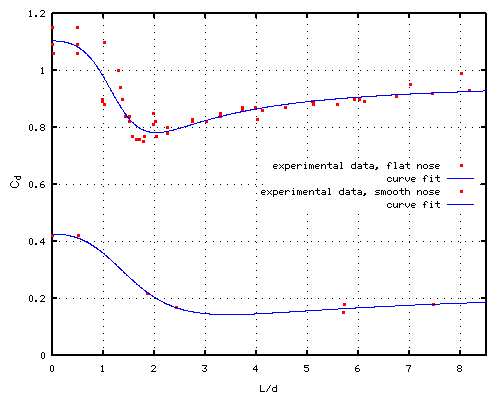The drag coefficient tells you how much drag affects an object moving in a fluid. A higher drag coefficient means that the drag force is larger, which’ll slow down an object more. Lower drag darts will have more range and travel faster.
What’s the drag coefficient of a Nerf dart? Many tests have been done on cylinders. I’ve plotted the results of these tests below. The data comes from this paper and this book.

This is a plot as a function of fineness ratio ( ), which is the ratio of the dart’s length to its diameter. This’ll allow the results to scale up for any size dart.
), which is the ratio of the dart’s length to its diameter. This’ll allow the results to scale up for any size dart.
Nerf darts seem to be much closer to the flat nose curve above than the smooth nose one. Tests done by Daniel Beaver have shown that Nerf darts with a length of 1.25 inches have a drag coefficient of about 0.67.
This plot shows that darts have the least drag in the range of  = 1.75 to 3. The increase in drag for darts shorter than that is much steeper than the increase for longer darts. The variability also increases for shorter darts, which could reduce accuracy. Based on this information, we should make our darts about 2.5 times as long as their diameter to have low drag and good accuracy.
= 1.75 to 3. The increase in drag for darts shorter than that is much steeper than the increase for longer darts. The variability also increases for shorter darts, which could reduce accuracy. Based on this information, we should make our darts about 2.5 times as long as their diameter to have low drag and good accuracy.
The curve fits I developed above use this equation:

For the flat nose,  = 1.104,
= 1.104,  = -0.988,
= -0.988,  = 0.402, and
= 0.402, and  = 0.413. For the smooth nose,
= 0.413. For the smooth nose,  = 0.427,
= 0.427,  = -0.579,
= -0.579,  = 0.060, and
= 0.060, and  = 0.248.
= 0.248.  is the drag coefficient of a cylinder with effectively zero length.
is the drag coefficient of a cylinder with effectively zero length.
Typical darts were longer at one time. Perhaps Nerfers have slowly have figured out that shorter darts perform better. In 2004, the average Nerf dart was 2.1 inches long ( = 4.0). In 2008, the average dart was 1.7 inches long (
= 4.0). In 2008, the average dart was 1.7 inches long ( = 3.2). Now I’d say darts are even shorter. Daniel Beaver’s tests used darts with a fineness ratio of 2.4, which is about what I suggest based on this data.
= 3.2). Now I’d say darts are even shorter. Daniel Beaver’s tests used darts with a fineness ratio of 2.4, which is about what I suggest based on this data.